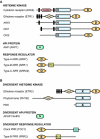Two-component signaling elements and histidyl-aspartyl phosphorelays
- PMID: 22303237
- PMCID: PMC3243373
- DOI: 10.1199/tab.0112
Two-component signaling elements and histidyl-aspartyl phosphorelays
Abstract
Two-component systems are an evolutionarily ancient means for signal transduction. These systems are comprised of a number of distinct elements, namely histidine kinases, response regulators, and in the case of multi-step phosphorelays, histidine-containing phosphotransfer proteins (HPts). Arabidopsis makes use of a two-component signaling system to mediate the response to the plant hormone cytokinin. Two-component signaling elements have also been implicated in plant responses to ethylene, abiotic stresses, and red light, and in regulating various aspects of plant growth and development. Here we present an overview of the two-component signaling elements found in Arabidopsis, including functional and phylogenetic information on both bona-fide and divergent elements.
Figures






References
-
- Alabadi D., Oyama T., Yanovsky M. J., Harmon F. G., Mas P., Kay S. A. Reciprocal regulation between TOC1 and LHY/CCA1 within the Arabidopsis circadian clock. Science. 2001;2936(1):880–883. - PubMed
-
- Anantharaman V., Aravind L. The CHASE domain: a predicted ligand-binding module in plant cytokinin receptors and other eukaryotic and bacterial receptors. Trends Biochem. Sci. 2001;266(1):579–582. - PubMed
-
- Appleby J. L., Parkinson J. S., Bourret R. B. Signal transduction via the multi-step phosphorelay: not necessarily a road less traveled. Cell. 1996;866(1):845–848. - PubMed
-
- Baker M. D., Wolanin P. M., Stock J. B. Signal transduction in bacterial chemotaxis. Bioessays. 2006;286(1):9–22. - PubMed
LinkOut - more resources
Full Text Sources
